Villista issues
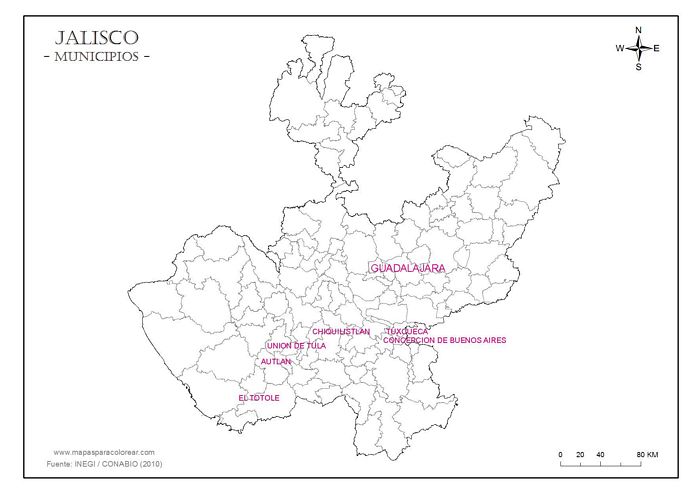
So-called Villista/Convencionista factions on the southwest of the state issued a series of notes to facilitate commerce. As these were very local (DelgadoRicardo Delgado, Las Monedas Jaliscienses durante la Epoca Revolucionaria, Guadalajara, 1938 does not mention them) and related to the eventual losers, little is known about them, including their sequencing, with the exception of the Autlán issues, which are documented in the local municipal archive. There was a wide variety of types, which might be down to different issues or differences within issues.
Among the military commanders were Roberto Moreno, Pedro Zamora, José Sánchez Gómez and Vicente Alonso Teodoro. Roberto Moreno was a prominent hacendado in Unión de Tula. At his hacienda de San Clemente the constant demands from military chiefs led him to take up arms and form a self-defence militia. He joined forces with Pedro Zamora to gain control over a wide swathe of territory. Despite being a major landowner, in his jurisdiction he abolished the tiendas de raya and cancelled workers’ debts. Moreno refused offers of amnesty and continued fighting until his death in 1917.
In contrast, Pedro Zamora was born to a poor peasant family in El Limón, in 1890. After a vicious youth he formed a group that adopted Constitutionalism and joined Obregón when he arrived in Jalisco. He followed Lucio Blanco in supporting the Convention and after a defeat, regrouped in Unión de Tula, where he declared himself a Convencionista and proclaimed religious liberty, in contrast to Manuel Dieguez’ anti-clericalism. With Roberto Moreno he attacked Díeguez’ forces, and in 1915 the Villista governor, Julián Medina, named him jefe militar of Autlán. After Villa’s defeat, the Carrancistas launched a campaign against Zamora and on 16 October 1916 Ramón F. Iturbe defeated him in Unión de Tula and, a little later, in El Grullo. He still had solid support in the region, violently refused an offer of amnesty by sacking Cocula, and continued to attack federal and state troops. The government finally mobilised 12,000 troops to get him. He surrendered on 12 November 1920 and was assigned to the hacienda of Canutillo, Durango, under Villa’s responsibility. He went missing in February 1921, was arrested in Mexico City and executedPedro Zamora stole his horse "Tlacuache" from General Jacinto Cortina, the owner of the Hacienda de Telcampana.
José Sánchez Gómez was a farmer and businessmen in La Huerta, where he enjoyed prestige as the local cacique. He also rebelled against the Constitutionalists’ attacks on his property, and held out until he accepted an amnesty in 1920.
Vicente Alonso Teodoro had been jailed on several occasions for assault, robbery and murder. From the end of 1914, he headed a small band of 30 to 80 men that committed all kinds of outrages in the municipalities of Colima, Comala and Villa de Álvarez. A few weeks before the Constitutionalists occupied Colima he was part of Huertista governor Antonio Delgadillo’s security forces. During Eduardo Ruiz’ tenure he was captured and sent back to prison because he was "the author of several murders and a protégé of the ex-general Delgadillo"Boletín Militar, Guadalajara, 15 September 1914 but escaped in the middle of September 1914 and took refuge in the mountainous area that extends between Colima and Jalisco, from where he would return as a lieutenant colonel in the Conventionist Army and integrated into the command structure headed by Roberto Moreno. He undertook actions in concert with Moreno's forces and with Pedro Zamora.
Autlán
Rafael B. Gómez
Ramón B. Gomez was owner of the Hacienda “El Totole”, in La Huerta, some miles from Autlán. He issued a series of vales for 5c, 10c, 20c and 50c, which circulated widely in the district. They are known in a variety of designs, fonts, text, colours (due to the use of any available paper) and with different validating seals. Some carry a seal of the General Headquarters of the Brigada Moreno (EJERCITO CONVENCIONISTA - BRIGADA "MORENO" - CUARTEL GENERAL) and so these are listed, mistakenly, as a military issue in catalogues including Mexican Paper Money (there are similar private issues, from Antonio R. Olivera in El Grullo, Juan Jiménez in El Limón and José V. Gómez, Teodoro Borbón and Herculano García in Purificación, without such a handstamp).
Series/Type 1
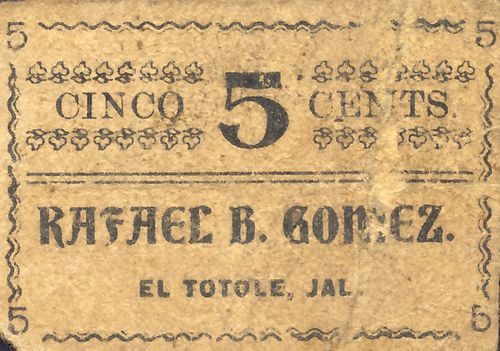
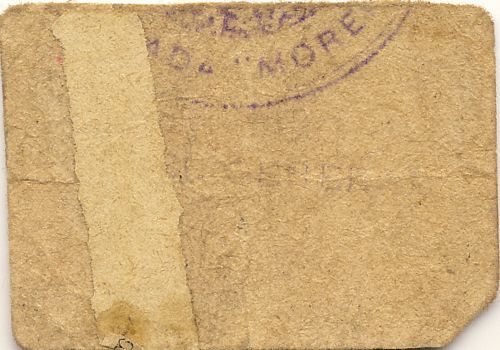 M2246 5c Rafael B. Gómez
M2246 5c Rafael B. Gómez
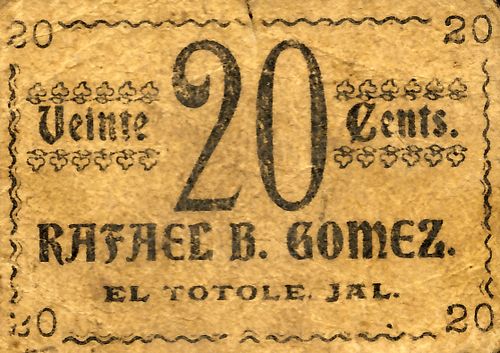 M2248 20c Rafael B. Gómez
M2248 20c Rafael B. Gómez
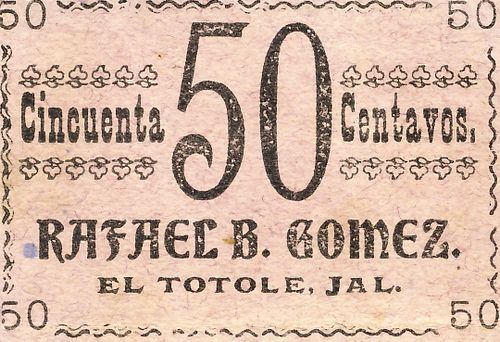
 M2249 50c Rafael B. Gómez
M2249 50c Rafael B. Gómez
Series/Type 2
One Rafael B. Gómez issue was entitled PROVISIONAL
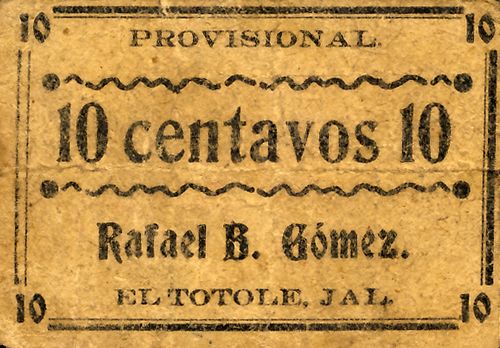 M2252 10c Rafael B. Gómez
M2252 10c Rafael B. Gómez
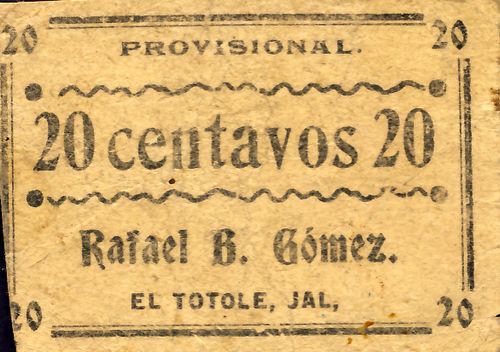
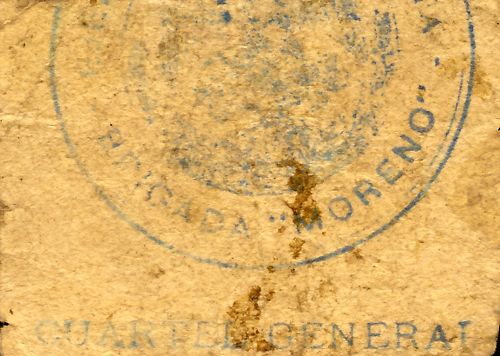 M2253 20c Rafael B. Gómez
M2253 20c Rafael B. Gómez
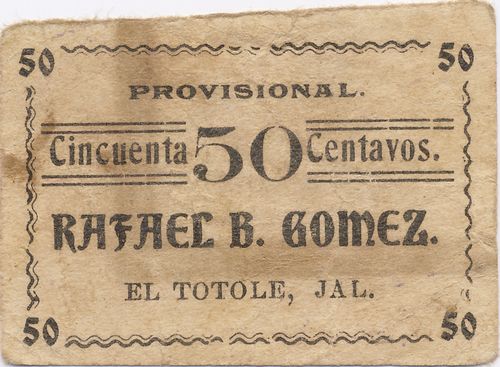
 M2254b 50c Rafael B. Gómez
M2254b 50c Rafael B. Gómez
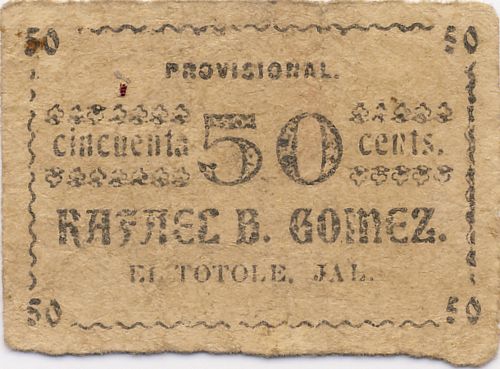
 M2254a 50c Rafael B. Gómez
M2254a 50c Rafael B. Gómez
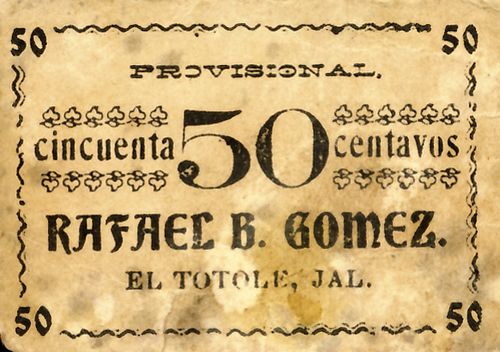
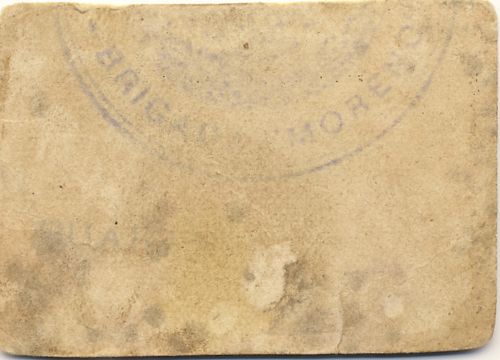 M2254a 50c Rafael B. Gómez
M2254a 50c Rafael B. Gómez
Series/Type 3
while another was designated VALE PROVISIONAL
 M2256 5c Rafael B. Gómez
M2256 5c Rafael B. Gómez
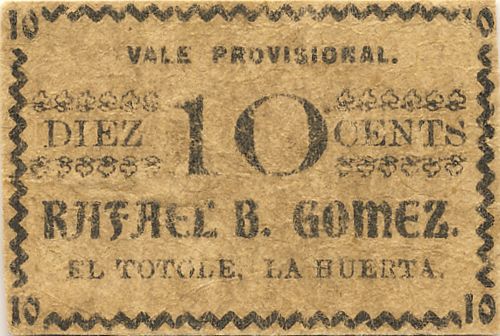
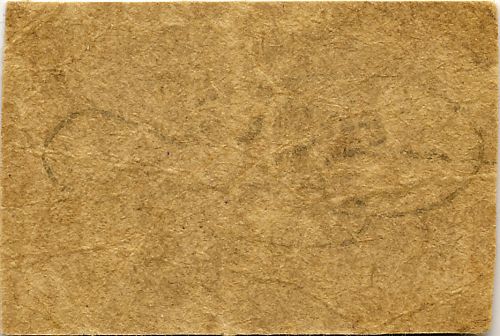 M2257 10c Rafael B. Gómez
M2257 10c Rafael B. Gómez
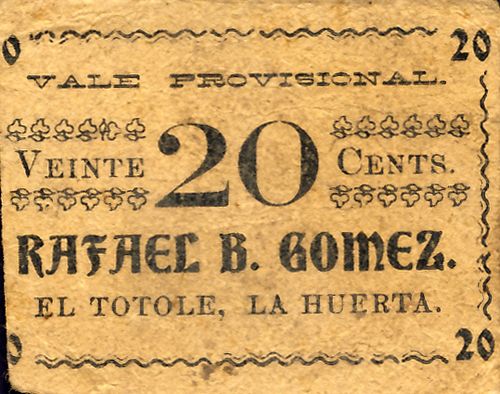 M2258 20c Rafael B. Gómez
M2258 20c Rafael B. Gómez
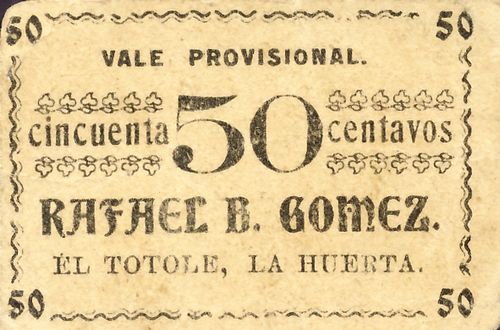 M2259a 50c Rafael B. Gómez
M2259a 50c Rafael B. Gómez
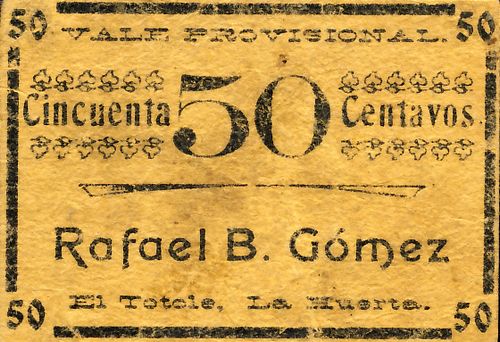
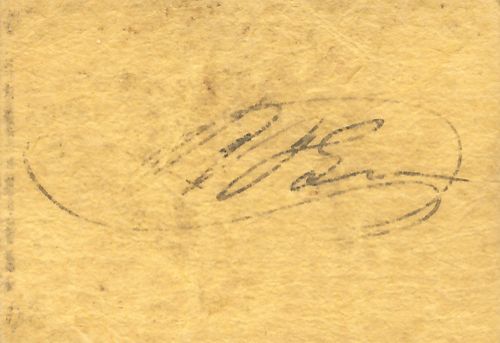 M2259b 50c Rafael B. Gómez
M2259b 50c Rafael B. Gómez
These were still being used in November 1915.
La Brigada "Moreno"
As stated, Roberto Adán Moreno was a hacendado in Unión de Tula. At his San Clemente hacienda the constant demands from military chiefs led him to take up arms and form a self defence militia, the Brigada Moreno, with himself as general. He joined forces with Pedro Zamora to gain control over the whole region around Autlán and imposed on the city its first Convencionista Presidente Municipal, José Maqueo Castellanos, on 12 March 1915. Moreno issued fichas that circulated throughout the region dominated by the Convencionistas, and were used to pay the troops, workers on the haciendas and public employees.
These were designated as from the head-quarters of the Convencionist Army and are known in a variety of colours and fonts. These were supposedly printed four to a sheet with one 5c, one 20c and two 50c.
Series/Type 1
EJERCITO CONVENCIONISTA in block lettering
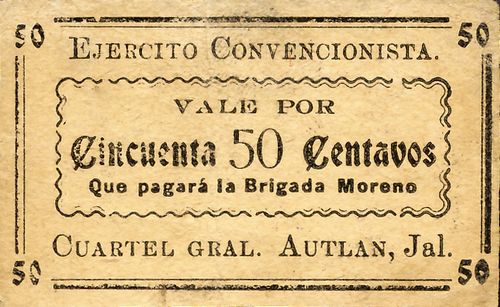
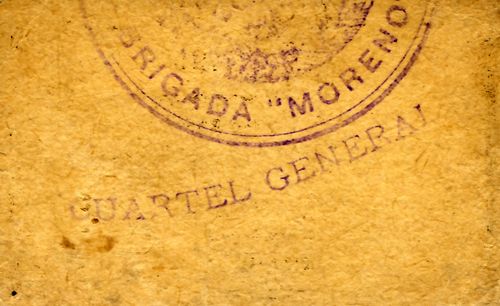 M2234a 50c Ejército Convencionista
M2234a 50c Ejército Convencionista

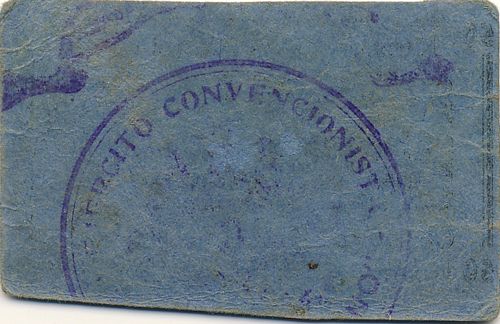 M2234c 50c Ejército Convencionista
M2234c 50c Ejército Convencionista
Series/Type 2
EJERCITO CONVENCIONISTA in thin block letters with a wavy border to the centre box
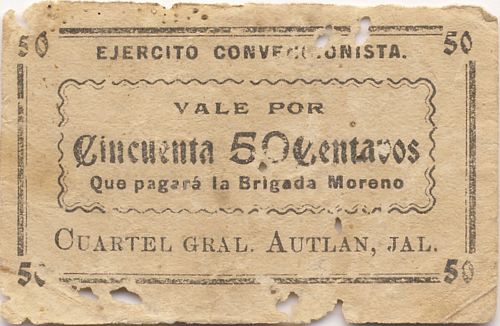
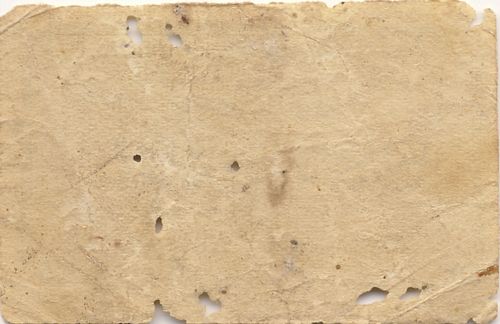 M2234b 50c Ejército Convencionista
M2234b 50c Ejército Convencionista
Series/Type 3
EJERCITO CONVENCIONISTA in italics, with a wavy border to the centre box
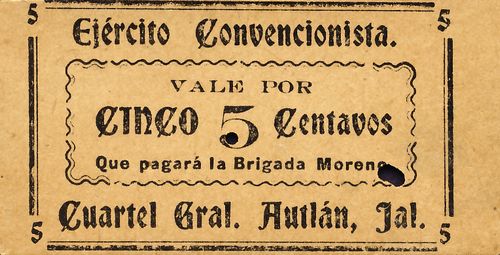
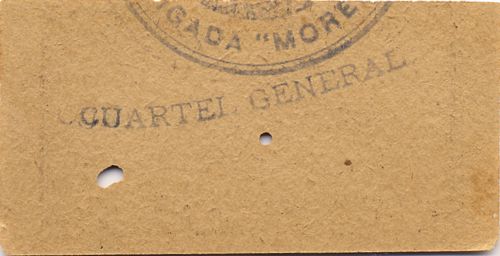 M2230a 5c Ejército Convencionista
M2230a 5c Ejército Convencionista
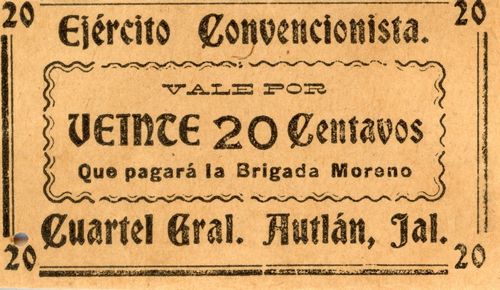 M2231a 20c Ejército Convencionista
M2231a 20c Ejército Convencionista
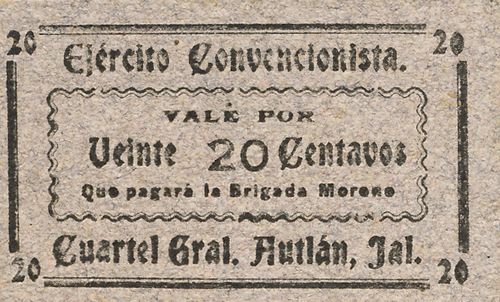
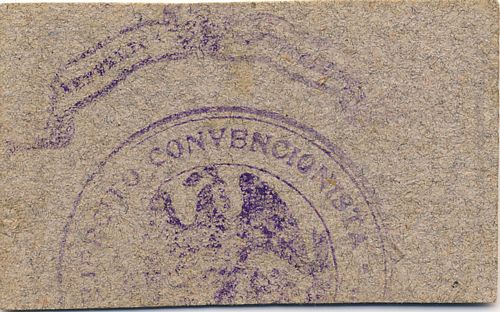 M2231b 20c Ejército Convencionista
M2231b 20c Ejército Convencionista
Series/Type 4
With straight edge to centre box
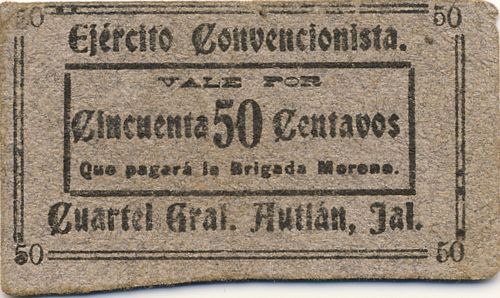
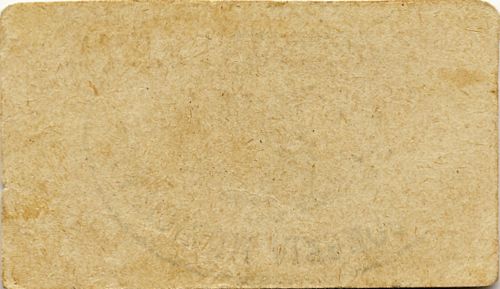 M2232b 50c Ejército Convencionista
M2232b 50c Ejército Convencionista
Series/Type 5
with Cuartel General spelt out in full
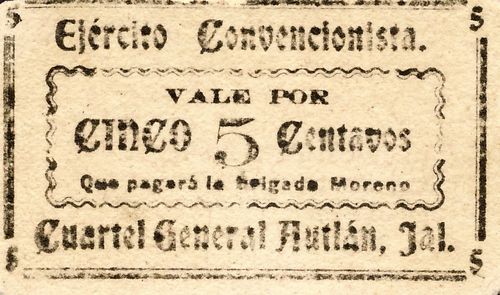 M2230c 5c Ejército Convencionista
M2230c 5c Ejército Convencionista
There are several references to consignments of notes from Salvador Araiza, the printer in Unión de Tula, who owned the region’s sole printshop, but no details of the total amount. On 19 June Epigmenio Ramos left Autlán with 3,000 sheetsAHMAut, Sección Gobernación (Sección 6), 1915. On 24 June Capitán Medina took 1,000 sheetsibid.. However, the printers were also occupied in producing fichas for José V. Gómez in Villa Purificación and someone in El Grullo (probably Antonio R. Olivera)ibid.. On 18 August Teniente Santiago García took a packet containing 1,000 hojas, making a total of $2,000 in 50c notesibid.. By 20 August Araiza was running out of paperibid..
A consignment of $19,951 taken by Capitan 1o. Domingo Araiza on 30 August included $14,000 in 7,000 hojas impresas de fichas de la primera y segunda emisiónibid. (the first reference to more than one issue).
Moreno’s issue was withdrawn when the Carrancistas arrived. On 27 November the Tesorero General reported that he had $460 in Brigada Moreno that were no longer in circulationAHMAut, Sección Hacienda (Sección 2), 1915, a sum that had risen to $584,50 by the end of the yearibid..
Moreno himself refused offers of amnesty and continued fighting until his death in 1917.
La Brigada Méndez
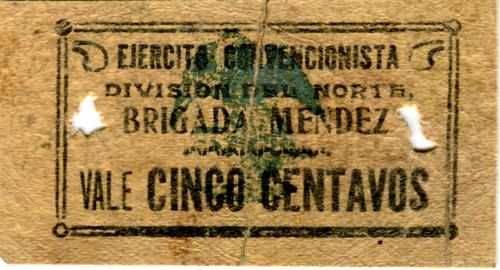
 M2063 5c Brigada Méndez
M2063 5c Brigada Méndez
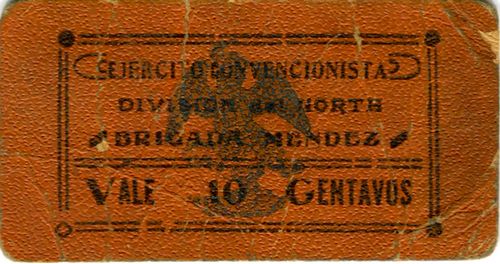
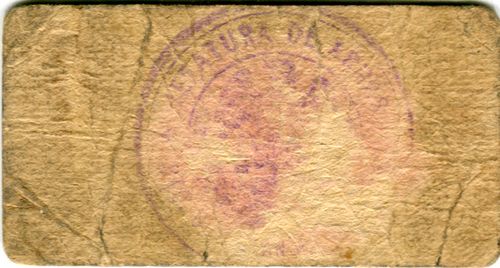 M2064 10c Brigada Méndez
M2064 10c Brigada Méndez
The 5c example has the annotation 'Lagos de Moreno' on the reverse.
Other Villista issues came from the centre of the state and were authorised by the local municipalities.
Chiquilistlán
Ejército Católico Villista
Chiquilistlán is a small town located in the Sierra Tapalpa mountains, at the foot of a hill called Chiquilichi, some 75 kilometres to the south-west of the state capital Guadalajara.
A $1 note dated 20 December 1914[image needed].
This may seem a strange combination of Catholic and Villista. However, Diéguez was anti-clerical so in January 1915 when the Carrancistas were regrouping to retake Guadalajara the Catholic churches there offered prayers for a Villista victory. As part of these activities, a large demonstration was organized of Catholics before the offices of Governor Julián C. Medina to express their support and to offer him support against his Carrancista opponents.
El Pinabete
3er Regimiento de Caballería
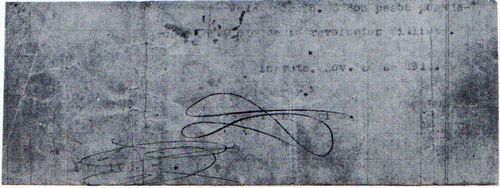 M2244 $2 3er Regimiento de Caballería
M2244 $2 3er Regimiento de Caballería
This is a $2 voucher, typewritten on ledger paper, dated 30 November 1914, from the Comandancia of the Tercer Regimiento de Caballería.
6a. División del Suroeste

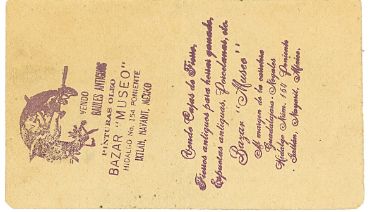 M Unlisted $5 6a. División del Suroeste
M Unlisted $5 6a. División del Suroeste
This $5 note purports to be an issue from the Cuartel General in El Pinabete. dated 5 May 1915, and payable at the triumph of the Villista Católica revolution. It carries the names of General Bernadino Ch. Real as Jefe de la 6a. División del Suroeste, 2o Jefe Coronel Rosalio Berumén and Secretario T. Coronel Plutarco Miramontes.
However, this is a later fantasy, created for collectors, as confirmed by the advert on the back. The hook neck eagle in the seal was never used during the Revolution.
Tuxcueca
Tuxcueca is a town 50 kilometres south of Guadalajara.
Ejército Villista
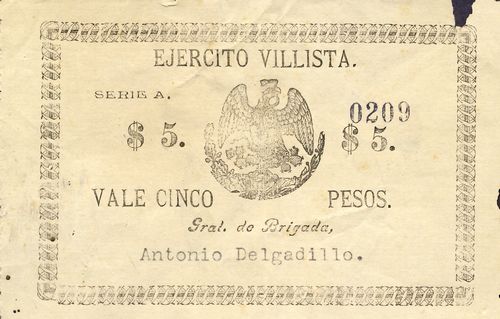
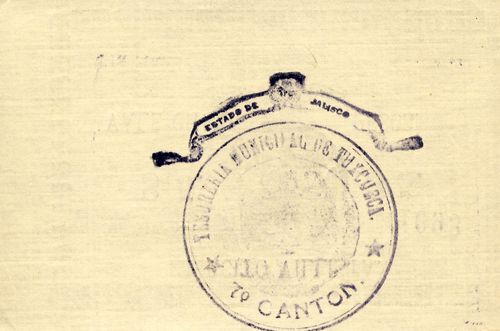 M2286a $5 Eército Villista
M2286a $5 Eército Villista
| series | from | to | total number |
total value |
||
| $5 | A | 0001 | includes numbers 0021CNBanxico #11341 to 0209 |
A $5 note, Serie A, with typed name Gral de Brigada Antonio Delgadillo and stamp on reverse ‘ESTADO DE JALISCO – TESORERIA MUNICIPAL DE TUXCUECA – 7o CANTON’. If this attribution is genuine, this note must date to late 1914.
|
[if addition of name is genuine, and if correct person] Delgadillo reappears as a Villista general under Julián C. Medina, in charge of troops that were keeping Diéguez in check in Guadalajara. On 25 December 1914 Delgadillo paraded his troops through Guadalajara but two or three days later he and others were arrested. Delgadillo and seven others were then shot in the cemetery in Poncitlán, Jalisco, without a case formed against them and without a declared motive. Some say it was because they intended to form a breakaway state and keep out of the fighting, some because they represented the clerical faction, and other because they meant to make Delgadillo governor. |
Concepción de Buenos Aires
Concepción de Buenos Aires is a town south of Guadalajara and east of Ciudad Guzmán.
Ejército Villista
A series of notes (5c, 10c, 20c and 50c) in various colours and designs with the stamp of ‘TESORERIA MUNICIPAL DE CONCEPCION DE BUENOS AIRES’. The numbers were originally handwritten but after c. 4900 they acquired a numbering machine.
The 5c design changed to spell out the denomination and the numbering of the variants 'VALE CINCO CENTAVOS', '5 CVS. VALE CINCO CENTAVOS' and '5 CVS. 5 CVS.VALE CINCO CENTAVOS' show that they appeared on the same sheet plate.
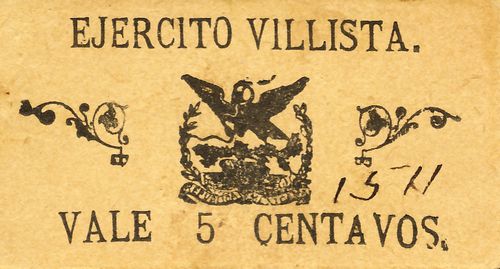 M2281 5c Ejército Villista
M2281 5c Ejército Villista
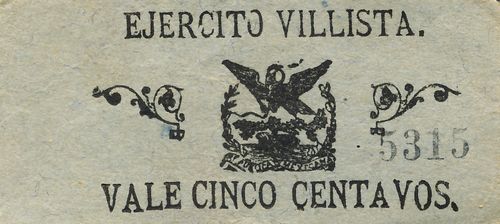 M2280 5c Ejército Villista
M2280 5c Ejército Villista
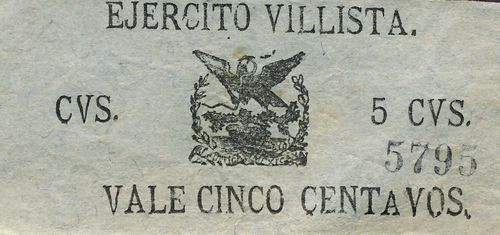
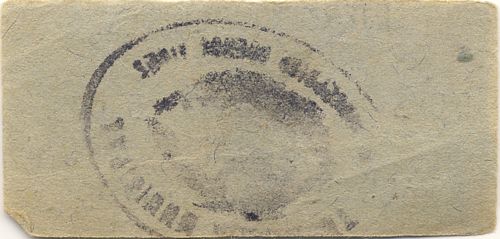 M2279b 5c Ejército Villista
M2279b 5c Ejército Villista
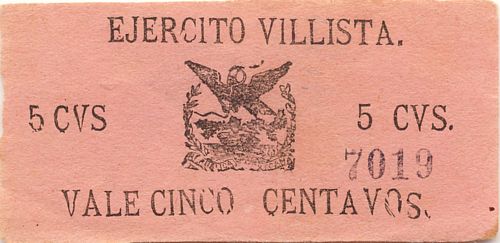
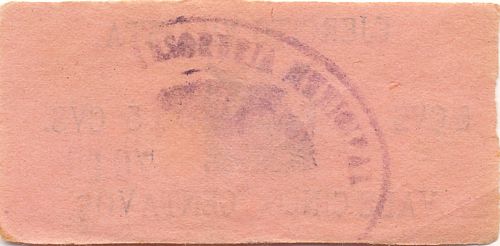 M2279a 5c Ejército Villista
M2279a 5c Ejército Villista
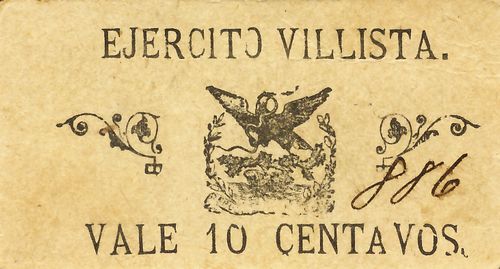 M2282 10c Ejército Villista
M2282 10c Ejército Villista
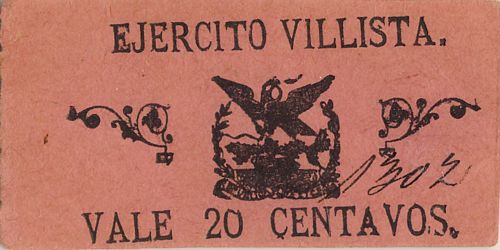
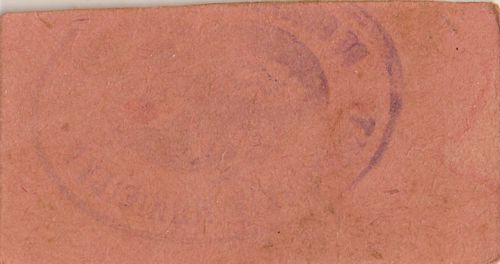 M2283 20c Ejército Villista
M2283 20c Ejército Villista
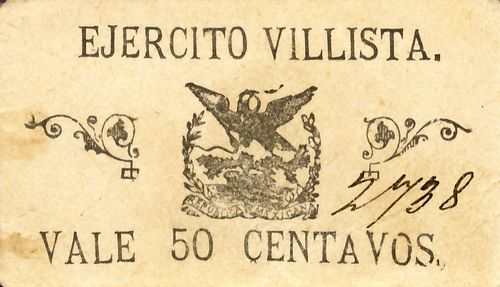
 M2284 50c Ejército Villista
M2284 50c Ejército Villista
| from | to | total number |
total value |
|||
| 5c | VALE 5 CENTAVOS | includes numbers 1511 to 3931 | ||||
| VALE CINCO CENTAVOS | includes numbers 5315 to 8022 | |||||
| CVS. 5 CVS. VALE CINCO CENTAVOS | includes numbers 5357CNBanxico #11335 to 5795 | |||||
| 5 CVS. 5 CVS.VALE CINCO CENTAVOS | includes numbers 4925 to 8998CNBanxico #11333 | |||||
| 10c | includes numbers 886 to 2388CNBanxico #11338 | |||||
| 20c | includes numbers 1302 to 1915CNBanxico #11339 | |||||
| 50c | includes numbers 842 to 3348 |
